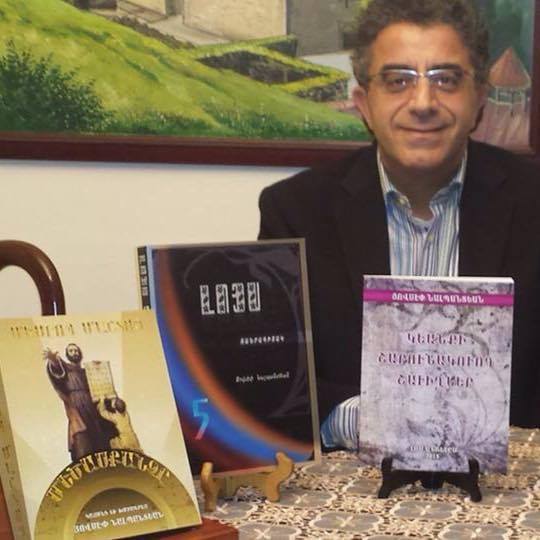According to Hovsep Nalbandyan, governments are changing but the homeland remains. In these days, an American philologist and literary critic, bibliographer, translator and publisher Hovsep Nalbandian is in Yerevan. The reason is the presentation of his 13th and 14th books. The author dedicated his two books to the 100th anniversary of the Armenian Genocide. The 13th book is entitled “Continued pathways of life” with 52 published and unpublished articles, the 14th is the bibliographic work “The Armenian Book in America”, which covers the years of 1857 to 2015 April, 3046 books of 1127 Armenian writers, a booklet and Memoirs. The author hopes that these books will also be well-accepted and help continuing the major bibliographic work of others.
Aleppo-origin Hovsep Nalbandian settled down in the United States in 1993. In the conversation with “Aravot”, he told that the first months were very harsh for him, he was in search for a job, he say that many people were reluctant to hire him, because he was not affiliated to any party. Ten months later, he studied computer skills and was hired at the “Masis” weekly as a typist, page-maker, vice-editor and proofreader. Because of the workload, he does not have time to publish the articles collected, edited and translated since his student years (1986-87). And since 1996, he both teaches and works on the weekly. In 1999, he prints the trial version of the book entitled “Luys. Basic knowledge” and distributes to the students edition by edition.
Our interlocutor tells that in 2000-2009, the 6 volumes of the “Luys” encyclopedia were published 13 times, by 16800 copies. In 2008-09, Nalbandian decided to create a new language selected anthologies for the Armenian students. In the meantime, the “History of the American-Armenian book,” “Brief history of Armenian dictionaries” are born, then comes the 9th book – the “Hayots Danteakan” by Hovhannes Shiraz in 62 unpublished lines, classic orthography, and finally, the “Armenian Language”. The 11th book is called “Collection of Orthographic materials: Dictionary”. The author says that the peculiarity of this book is that it includes works of many writers with both Western Armenian classical and Eastern Armenia orthography. This book was followed by “The Great Mesrop Mashtots” extensive volume, then the last two books – “Continued pathways of life,” and “The Armenian Book in America.” The last book is the revised version of the work “The History of the American-Armenian book”. We asked Hovsep Nalbandian whether being engaged in Armenian studies abroad is not just an entertainment of a soul. Our interlocutor said that it is a tough work, but a pleasant one. He also added that after 2009-09, he was not included in various schools because, according to local laws, the experts having experience and rating in the sphere should be paid more, therefore, they preferred inviting non-professional teachers and pay half of what they should be paid. That is why Hovsep Nalbandian decides to be engaged in purely Armenian studies and bibliographic work since 2009, also publish books. His 15th and 16th books are “not behind the seven hills”.
Hovsep Nalbandian made 9 visits to Armenia, he says that every time he gets charged from contacting with the writers, professionals and public figures in Armenia. He regrets that many of our fellow citizens in Los Angeles are picking on Armenia, and he is trying to explain people disputing that the governments are changing, but the homeland remains. Nalbandian does not consider the crisis in reading a purely Armenian or American-Armenian “disease”, he says that it is common everywhere. I think that simply the print book should be more advocated, especially when only the 4 percent out of 7 million printed books are found on the Internet, while the 90 percent of Armenian writers are not even presented. According to him, in the Netherlands, Germany, London and elsewhere, reading a printed book is already encouraged, reading awards were given, and it is time for Armenians to take on such a job.
Read also
Gohar HAKOBYAN




























































